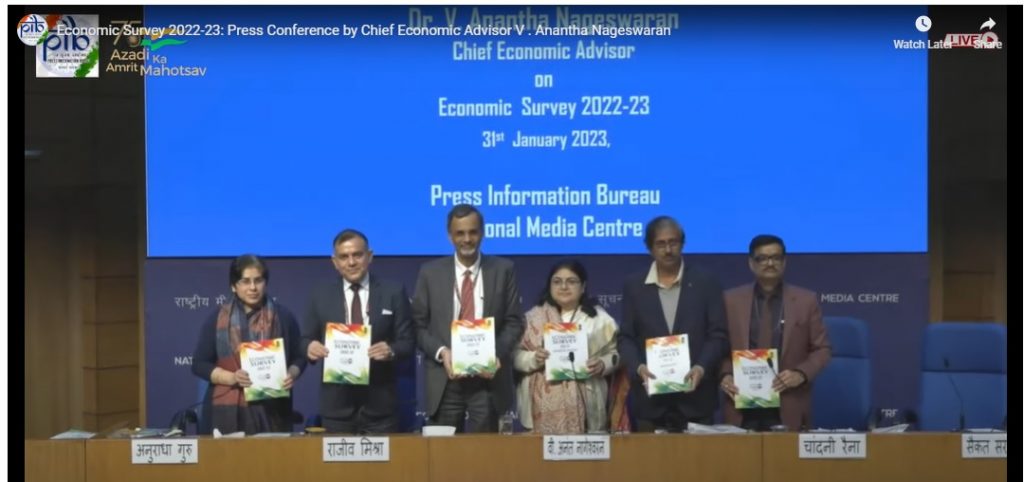
Indian Economy to grow at its potential in the coming decade:
The Economic Survey 2022-23 has revealed a significant improvement compared to 2015-16 in a variety of metrics pertaining to the quality of life in rural areas, with the majority of health indicators registering an impressive uptick.
These outcome-oriented statistics demonstrate tangible medium-term progress in rural living conditions, assisted by a policy focus on basic amenities and effective programme implementation.
As many as 21.9 crore beneficiaries have been verified under the Ayushman Bharat Pradhan Mantri – Jan Arogya Yojana (AB PM-JAY) Scheme including 3 crore beneficiaries verified using state IT systems as of January 4, 2023. Approximately 4.3 crore hospital admissions, amounting to Rs 50,409 crore, have also been authorised under the scheme through a network of over 26,055 hospitals. The Survey further observes that digitization of the insurance market and an increase in FDI limits will support the growth of India’s insurance sector.
India’s pension sector is also witnessing government initiatives to increase pension literacy, and a nudge to young adults to join pension schemes. Chief Economic Advisor Dr V Anantha Nageswaran along with his team explained the salient features of the Economic Survey 2022-23 after it was tabled in the Union Parliament on Tuesday.
Demand Stimulus to Industrial Growth
India’s GDP growth is expected to remain robust in FY24. GDP forecast for FY24 to be in the range of 6-6.8%. Retail inflation is back within RBI’s target range in November 2022. The gross tax revenue registered a y/y growth of 15.5% from April to November 2022, driven by robust growth in the direct taxes and goods and services tax (GST). The centre’s capex has steadily increased from a long-term average of 1.7% of GDP (FY09 to FY20) to 2.5% of GDP in FY22 PA. The centre has also incentivised the state governments through interest-free loans and enhanced borrowing ceilings to prioritise their spending on capex. Robust growth in private final consumption expenditure, export stimulus during the first half of the year, increase in investment demand triggered by enhanced public capex and strengthened bank and corporate balance sheets have provided a demand stimulus to industrial growth.
Social sector expenditure increased to Rs 21.3 lakh crore in FY23 (BE) from Rs 9.1 lakh crore in FY16. Institutional credit to the agricultural sector continued to grow to 18.6 lakh crore in 2021-22. India’s inflation management has been particularly noteworthy and can be contrasted with advanced economies that are still grappling with sticky inflation rates.
Credit to the service sector has grown by over 16% since July 2022. The services sector is expected to grow at 9.1% in FY23, as against 8.4% (YoY) in FY22. Sustained growth in the real estate sector is taking housing sales to pre-pandemic levels, with a 50% rise between 2021 and 2022.
Strong capital markets
The Survey states that the Indian stock markets witnessed a resilient performance, with the blue-chip index Nifty 50 registering a return of 3.7% during April-December 2022. The number of SMEs coming with IPOs was almost double compared to the FY 2022 (till November 2021), and the total funds raised by them were almost three times the funds raised in the same period last year.
Resilience in Fiscal Performance
The gradual decline in the Union government’s fiscal deficit as a percentage of GDP, in line with the fiscal glide path envisioned by the government, is a result of careful fiscal management supported by buoyant revenue collection over the last two years, stated the survey. The fiscal deficit is expected to be at 6.4% of GDP in FY 23. The Survey highlighted that conservative budget assumptions provided a buffer during global uncertainties. The resilience in the fiscal performance was due to a recovery in economic activity and buoyancy in revenues.
A total of Rs 7.5 lakh crore of capital expenditure is budgeted for FY23, of which more than 59.6% has been spent from April to November 2022. It is considered a counter-cyclical fiscal tool that strengthens aggregate demand, generates employment and boosts other sectors. The revenue expenditure of the Union government was brought down from 15.6% of GDP in FY21 to 13.5% of GDP in FY22 Provisional Actual (PA). This contraction was led by a reduction of the subsidy expenditure. However, around 94.7% of the budgeted expenditure on subsidies has been utilised from April to November 2022 due to the sudden outbreak of geopolitical conflict resulting in higher international prices for food, fertiliser and fuel. India’s public debt profile is relatively stable and is characterised by low currency and interest rate risks. Indian economy is thus well placed to grow at its potential in the coming decade, similar to the growth experience of the economy after 2003, states the Survey.







